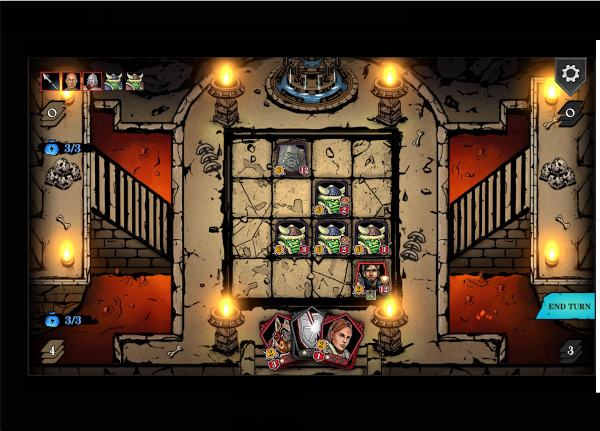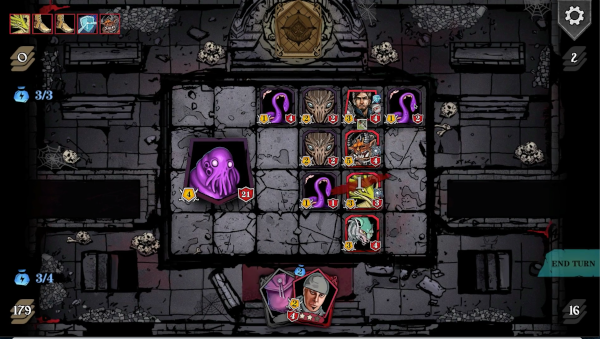Interview: Spellsword Cards: DungeonTop Dev Team
A roguelike deck-building game dropping players into tabletop battles, Spellsword Cards: DungeonTop occupies an evolving space in the world of electronic experiences, uniting the mechanics of old-school card games and modern play. With a focused interest in the translation of board games into fast-paced indie titles, I spoke with the dev team on their recently-released project.
Erik Meyer: Spellsword Cards: DungeonTop bridges the gap between tabletop deck building and the electronic realm; with that said, I see a new genre evolving (roguelike permadeath deck-builder), not quite phone games but different from traditional RPGs or tabletop wargames. For the uninitiated, how would you describe the overall experience of your work and the challenges you present for the player?
Spellsword DungeonTop: DungeonTop draws from both the new wave of deckbuilders and classic grid-based tactics games. You’re right that we’re nowhere near traditional RPGs, but the DNA of classic wargames is very much in the game – All the way back to chess. DungeonTop should feel like a tactical challenge for the player, as they use the tools at their disposal to overcome powerful enemies.

EM: Spellsword Cards: Origins and Spellsword Cards: Demontide represent previous creations by your studio, so how do those development cycles help shape your current work? What challenges and wrong turns can you avoid with the benefit of hindsight?
SDT: I (Bryn, the designer) joined the team at the start of DungeonTop’s dev cycle, so I can’t speak for the team’s prior learnings – But they had a wealth of technical knowledge built up that I’ve been happily exploiting. One of the things I think we do really well is get stuff done fast. And I’ve been able to mine the previous games for gameplay concepts and things that resonated with the team’s existing audience.
EM: Your site includes lore that fleshes out the fantasy world in which the game takes place; for players interested in deep dives, what important elements of the Spellsword universe set it apart from other similar settings? What key events/technologies/customs should push people back in their seats? What has brought us to this point in history?
SDT: The Spellsword Cards universe is growing with each game, a new tapestry of lore being woven. You could say DungeonTop and the other games are set in the “Third Age” of this setting, the heroic dawn of man. The lore is perhaps a little sparse right now, but with each new card I make for DungeonTop, the setting grows a little more solid, and the story of the world unfolds a little more. One idea that I loved from the previous games was the Steel Curse, a vicious spell that destroyed the arms and armor of mankind’s various civilizations, and the way they’ve had to adapt around it. I’m hoping to play more with that in the future.

EM: The game’s art and overall look brings me back to some of the games of my youth, so from a look/feel standpoint, what has guided your creation of art assets? And when it comes to grid combat, what design hurdles come with making skirmishes satisfying?
SDT: I think the reason we seem so similar to the games of old in our art style is we have the same driving force behind our art assets – expediency. We’re a very small team, making do with what we can, so we’ve got some of that oldschool pioneering spirit, working within limitations other teams have forgotten all about. As for making grid combat satisfying – You need to give the mind something to chew on. You can have the ‘juciest’ game in the world with the slickest animations and crunchiest sounds, but if there’s no strategic depth to the choices the player is making, there’s no point. That’s not to say that each choice must be infernally difficult – It’s okay to have obvious choices, as long as they lead to another, less obvious choice.
EM: Some fans/gamers are more vocal than others, so as you’ve honed and polished the project, what kinds of feedback have been helpful (on social media, feedback forms, or otherwise)? In following, with so many games out there, what do you view as solid, well-executed play?
SDT: All feedback is valuable – Even if someone comes into our discord spewing bile (even though I’d prefer they didn’t), I can usually glean some sort of opinion from it. Silence is far more terrifying than a few swear words. The most appreciated feedback though is well-reasoned critique. Some people, when giving feedback, imagine a whole new, vastly superior game that they then decide we should build for them, then and there. This is ridiculous. But if someone types up a paragraph explaining a very particular, detailed change, it fills me with a warm and fuzzy feeling. It shows they’ve actually engaged with the game as it exists, not the imaginary game in their head.

EM: I’ve seen deck-building games/board games/indie games shift a lot in recent years, moving away from longer game runs to shorter experiences; maybe the average gamer is older now, with kids, and can’t devote 5 hours a day to an immersive experience. How do you see this aspect of gameplay evolving, and how do you incorporate the fast-play, fast-reward, easy-to-drop-in elements into your work?
SDT: I think these fast-play, drop-in/drop-out elements are ultimately just kindness to your players. I don’t want our game to become a chore to play, so it saves whenever you exit and the run time is relatively short; about an hour or so to finish a game of DungeonTop. I think these sort of things are a natural evolution across the game space; it doesn’t just have to do with the relative age of gamers, but what gamers are adapted to. If you could play one game that makes you feel smart every five minutes, and another game that makes you feel smart every hour, naturally you’d prefer the first one, and play it more – And now that the five-minute-game exists, one-hour-games struggle unless they can increase the intensity of the experience. So one-hour-games die out, and five-minute-games rule, for now.
EM: To quote your site, “We wanted to make a chess-like game but without all the boring bits.” When it comes to making a lasting Slay the Spire-styled game, what do you see as essential components, and where do you have room to set yourselves apart?
SDT: Inevitably in the roguelike deckbuilder field we’re going to draw comparisons to Slay the Spire. You can take one look at our game and see we have many differences from them, and meaningful differences too, but I think what’s more interesting to me as a game designer are the points where we are very similar – Drawing cards, playing them. We ape this physical tradition in a digital medium because it feels so incredibly natural to play a card onto a board, and from there, certain decisions flow; we center our hand of cards, put the mana somewhere visible but out of the way of the main action. The essential components are not game mechanics per se but the inherited language of games that shows so strongly in the UI.

EM: On your website’s timeline, you’ve noted the game’s release on PC via Steam’s Early Access (Jan 15, 2020); with that in mind, what does your workflow look like within the studio? What kinds of things do you still need to tackle?
SDT: Given we’re getting back to you post-launch, you can imagine what our workflow was like – A hectic scramble. And it’s only just slowed down now after launch week, with all the bugfixing we needed to do. Still, I’m happy and proud to say none of us had to crunch.
In case you missed it, here’s the trailer:




